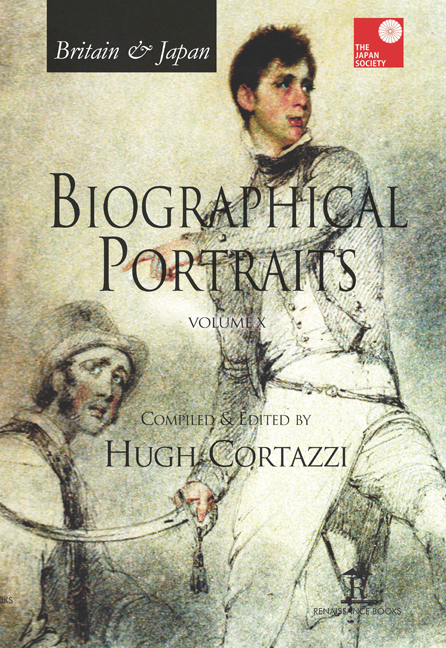Book contents
- Frontmatter
- Dedication
- Contents
- Introduction
- List of Contributors
- Index of Biographical Portraits in Japan Society Volumes
- PART I BRITAIN IN JAPAN
- PART II JAPAN IN BRITAIN
- Select Bibliography of Works in English on Anglo-Japanese Relations [Compiled by Gill Goddard – Retired East Asian Studies Librarian, University of Sheffield]
- Select Bibliography of Works in Japanese on Anglo-Japanese Relations [Compiled by Akira Hirano, SISJAC]
- Index
52 - Young Japanese Diplomats Sent to Study at British Universities
Published online by Cambridge University Press: 07 May 2022
- Frontmatter
- Dedication
- Contents
- Introduction
- List of Contributors
- Index of Biographical Portraits in Japan Society Volumes
- PART I BRITAIN IN JAPAN
- PART II JAPAN IN BRITAIN
- Select Bibliography of Works in English on Anglo-Japanese Relations [Compiled by Gill Goddard – Retired East Asian Studies Librarian, University of Sheffield]
- Select Bibliography of Works in Japanese on Anglo-Japanese Relations [Compiled by Akira Hirano, SISJAC]
- Index
Summary
INTRODUCTION
EACH COUNTRY HAS its own system of training its diplomats in linguistic and other skills required for their career. After it faced the stark challenge of communicating effectively in the cut and thrust of the Paris Peace Conference in 1919, the Japanese foreign ministry started sending its young recruits to universities in Britain, the United States, Germany, France and other countries, in limited numbers up until the beginning of the Pacific War. When the foreign ministry was resurrected after the hiatus of the war and the Allied occupation, the policy became established and has continued on an expanded basis to this day.
The training scheme has been closely linked to the ‘career’ system for Japanese diplomats. The ‘career diplomats’ were recruited through the higher diplomatic service examination, which was in place between 1894 and 1948.1 This was a separate examination from the higher civil service examination for domestic ministries, and had a foreign language proficiency test. This examination was continued until 2001, when it was merged with the civil service examination to broaden the basis of recruitment. Those who passed the examination were groomed as all-round generalists who would become ambassadors and senior officials in the ministry. In this portrait, they are called ‘A Track’ officers. There were also separate examinations to recruit consular officers or specialists in a variety of foreign languages or particular fields of expertise, who were called ‘B Track’ officers. This account focuses primarily on A Track officers up until the late 1970s, when the scheme was expanded to B Track staff.
MUTSU HIROKICHI
The first Japanese ‘career diplomat’ who had an Oxbridge education was Mutsu Hirokichi, son of the legendary foreign minister Count Mutsu Munemitsu, who concluded the revised Anglo-Japanese Treaty of Commerce and Navigation of 1894 and was the lead Japanese negotiator for the Treaty of Shimonoseki, which ended the First Sino-Japanese War (1894–1895). As recounted by his son, Yonosuke Ian Mutsu, Hirokichi was sent by his father to England and arrived at Cambridge at the age of twenty-four in April 1888, having spent the previous year for intensive study of English at University College, London, and under private tuition. He stayed at the home of the Passinghams, whose daughter Ethel (Japanese name Iso) he would marry in Japan in 1905. He studied law at Trinity College, Cambridge, then moved to London where he passed the examinations in the Inner Temple, and returned to Japan in 1894, passed the higher diplomatic service examination in 1895 (according to the foreign ministry tradition of identifying the cohorts of recruits by the year in which they passed the examination, he belonged to the ‘class of 1895’) and became a diplomat in 1895. Upon his father's death in 1897, he became a count. He served in Peking, San Francisco and London, where he was closely involved in preparing and staging the Japan-British Exhibition in 1910. Although he was appointed as minister to Belgium in 1914, he took early retirement due to ill health and devoted the rest of his life to philanthropy and education until his death in November 1942.
- Type
- Chapter
- Information
- Britain & Japan Biographical Portraits Vol X , pp. 584 - 598Publisher: Amsterdam University PressPrint publication year: 2016



